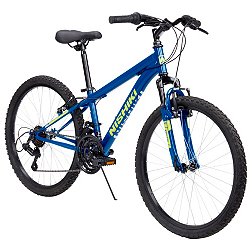What is the difference between a Trail Bike and a Mountain Bike?
There are two basic types of mountain bikes, trail bikes and all-mountain bikes. Trail bikes are a general take on traditional mountain bikes that are great for riding on packed rails, dirt roads and uneven ground. All-Mountain Bikes can be built with sturdier frames and full suspension for more steep descents and challenging rides.
What Are Mountain Bike Wheel Sizes?
Mountain bikes are available with a variety of wheel sizes, some of the most common sizes are:
- 26-inch Wheels: Many basic mountain bikes are equipped with compact and agile 26-inch wheels
- 27.5-inch Wheels: This wheel size is sometimes considered the industry standard and bridges the gap between 26-inch wheels and 29-inch wheels by offering a balance of maneuverability and rollover resistance.
- 29-inch Wheels: This wheel size offers more momentum, rollover resistance and traction.
What Type of Suspension System Do I Need?
There are two main types of mountain bike suspension systems, full-suspension and front-suspension.
Front-Suspension Mountain Bikes have a suspension fork on the front wheel to improve steering and reduce fatigue.
Full-Suspension Mountain Bikes utilize front and rear-wheel suspension. This suspension performs well on rugged and technical terrain and is best for bikers who want a ride that's easier on their muscles and joints.
What Are the Different Types of Mountain Bike Frames?
Aluminum is one of the most common mountain bike frame materials. Aluminum frames are lightweight, durable and an ideal combination for riding on technical terrain. Steel-frame mountain bikes offer a sturdy, smooth and fluid ride, but may be too heavy for some riders.
What Types of Brakes Should My Mountain Bike Have?
Disc Brakes: Disc brakes use a hard, metallic-based pad attached to the wheel hub to prevent debris from affecting braking. There is a large amount of clearance beneath this brake type so it's ideal for taking on muddy areas. Disc brakes come in mechanical and hydraulic models. Pro Tip: Hydraulic models tend to provide more control while breaking.
Linear Brakes: this type of break is also commonly called "v-brakes". Linear brakes are a side-breaking mechanism that draws the bike cable housing arms together to come to a stop.


















































